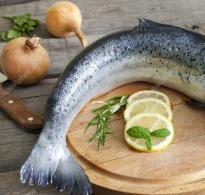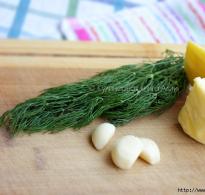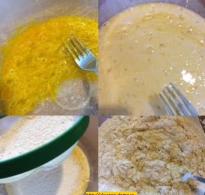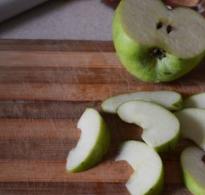Mangold - planting and care in the open field, cooking recipes. Harvesting chard for the winter: the best recipes
Like spinach, chard leaves shrink when steamed or boiled, so fill a large saucepan with leaves to the brim for 4 small to medium servings.
What can be made from chard
The easiest way to make chard is to boil it. Wash off with cold water. Remove too thick stems, cut off other stems and fry separately. Leave the small leaves intact and cut the large ones into pieces. Place in a large saucepan and cover with water just enough to cover them. Cook over high heat, stirring occasionally, until the leaves are soft and the volume is noticeably reduced. Drain, season with salt and serve. You can use a lump of butter or some nutmeg.
Puree:
Boil water before preparing the chard. Steam the leaves, stirring constantly, then drain the water thoroughly and squeeze dry. Place in a blender adding 10 grams of butter and a pinch of nutmeg for every 100 grams of leaves. Mash and season with salt to taste.
Beetroot recipes are very simple and straightforward - you can cook the leaves and stems together or separately. Select small leaves or cut into large pieces. Wipe them off if necessary. Heat the sesame oil in a wok or large skillet and sauté over high heat for 1 to 2 minutes, stirring constantly. Add sesame seeds or finely chopped garlic for flavor.
The stems can be used like ordinary vegetables - Swiss chard and dishes made from it can be not only an excellent side dish, but also an independent treat. Separate them from the leaves and cut into chunks, then sauté over high heat for 2-3 minutes, until golden and crispy.

Look at the photos of Swiss chard dishes - they will even decorate the festive table.
How to cook chard stew with butter

Chard dishes are very nutritious and satisfying. This is why it is best served with simple grilled meats or fish.
Serves 4:
- 2 kg of chard
- 75 g butter
- 75 g grated Parmesan
- salt, black pepper
Steam the chard, stirring constantly. Dry and place in a skillet. Add butter, half a serving of grated cheese and black pepper, fry for 1 minute over low heat, stirring constantly. Add the remaining cheese, season with salt and serve.
Simple beetroot recipes and photos

An excellent recipe for chard for dinner - the treat should be served with head salad and baked tomatoes on a branch.
Serves 4:
- 800 g stalks of "rainbow" chard
- a piece of butter
- 400 ml white sauce
- 50 ml milk
- 75 g cheddar cheese
- 40 g dry bread crumbs
Fry the whole chard stalks in butter over medium heat with constant stirring for 3 minutes or until tender. Place on the bottom of a shallow ovenproof dish.
Dilute the white sauce with milk, stir well and pour over the chard.
Top with grated cheese mixed with bread crumbs (breading). Bake at 200 ° C for 20-25 minutes, until the surface is golden brown.
Garnish for meat:

This wonderful side dish is a great partner for roast lamb. If you put a soft-boiled egg on top, then it can be served instead of dinner.
Serves 4:
- 6 stalks shallots
- 8 cloves of garlic
- 2 tbsp. tablespoons of olive oil
- 1 kg of ruby chard
- 150 ml vegetable broth
- a can of canned chickpeas weighing 400 g
- salt, black pepper
Sauté finely chopped shallots and garlic in oil in a large skillet over medium heat for 3 minutes until soft and golden.
Chop the stalks and leaves of large chard. Place half in the skillet and stir until the volume is halved - this will take about 2 minutes. Put the remaining chard in the same place and stir again.
Pour broth on top, add chickpeas from a jar without liquid and boil everything for 5 minutes.
Drain the liquid. Drizzle with olive oil, season with salt and pepper and serve.
Ricotta Lasagna:

Serve with garlic bread and salad.
Serves 4:
- 8 sheets of lasagna dough
- 1 kg beetroot
- 1/2 teaspoon ground nutmeg
- 500 g cheese
- salt, black pepper
- 400 ml tomato sauce
- 400 ml white sauce
- 75 g grated Parmesan
Do not use lasagna sheets that say “no precooked” as this recipe does not contain enough liquid.
Preheat oven to 190 ° C. Cook the lasagna sheets until tender, drain the water, leaving 1 tbsp. a spoonful of liquid.
Steam the chard, stirring constantly, drain, salt, pepper and add nutmeg. Place the ricotta cheese in there and keep the mixture warm. Heat the tomato sauce and white sauce over the fire.
Place the lasagne on a buttered square fireproof dish in the following order: layer of dough, half of the tomato sauce, all of the beetroot and ricotta mixture, the rest of the tomato sauce, the rest of the lasagna dough, all of the white sauce. Sprinkle with grated cheese on top. Bake for 20 minutes.
Now you know that you can cook almost any dish from chard - from a simple side dish to a wonderful lasagna.
I would like to introduce you to one vegetable plant with an interesting and unusual name - chard. Planting and care in the open field is so easy that the hassle of growing will be minimal. I had an interesting story with Mangold beets. I sowed beet seeds somehow. I bought two varieties, made two furrows and sowed one variety into one and the other into the other. She threw out the seed bags without even bothering to remember their names. Both varieties emerged almost simultaneously.
It's time, I thinned my beets. Watered, loosened the aisles. Everything is as usual. And then I noticed that the tops on one row are more luxuriant, the leaves are large with thick red petioles. The leaf grows "stupid", has grown almost above the knee, and the root does not even think to be rounded. On the second, the leaves are much smaller, roots began to be tied. With a shrug, I decided that the seeds were to blame, I was out of luck with them. At first I wanted to pull out the unsuccessful beets - the granddaughter interfered, she liked the juicy beautiful leaves. How she guessed that they were edible, I don't know. But, coming to the dacha, the first thing she did was to run to this bed, pick off a whole bunch of leaves and eat them with pleasure.
Here's a funny story ...
 Chard in the salad garden
Chard in the salad garden Only the next year, looking through information on the Internet, I found out that there is a special kind of beet - the Mangold leaf beet. It became interesting. I already bought Mangold seeds specially. And having received an incomparable harvest, I realized that I would never part with this amazing plant - chard. How many delicious dishes you can cook with it! I'll talk about this too, but a little later.
Mangold what is it
Chard is a fairly powerful plant that can grow 60-70 cm high. It depends on the variety. Mangold is a close relative of the common beet, but it does not form a root crop, but is valued precisely for its ground part - a lush rosette of large bubbly leaves, towering above the ground on tall thick petioles.
Chard has several names - shnitt chard, leaf chard, petiolate chard. It is grown for the sake of obtaining tasty and unusually healthy leaves.
Not only leaves are eaten, but also juicy fleshy stems, which, with proper care, reach a diameter of 7-8 mm. The petioles, just like the leaves, are incredibly rich in vitamins, minerals, trace elements and a variety of valuable compounds. If you introduce into your diet the regular use of this vegetable plant, you can in the best way raise your immunity, strengthen your health.
Of those varieties that I planted on my site, the high yield especially liked the mid-season variety of chard Bride, which allows the first cut of greenery 55-65 days after germination. The plant reaches a height of 50-60 cm, has large wavy dark green leaves and very thick white petioles, which are especially juicy and piquant taste.
 Variety Bride
Variety Bride The Krasavitsa variety, which ripens at the same time, is no less tasty. This Swiss chard variety also allows for several cuts per season and has a high yield. In addition, it is also unusually decorative: a lush rosette of green leaves with red veins reaches a height of 60-70 cm and looks very elegant in the garden, thanks to its bright crimson thick petioles. And he can decorate any flower garden!

Chard - care and cultivation
Mangold is unpretentious in care, and even a novice gardener can grow this culture. Its seeds begin to germinate already at a temperature of + 6-7 ° C, so I sow them on a garden bed filled with organic matter and mineral fertilizers in the early spring.
Young shoots of Swiss chard are cold-resistant and tolerate spring frosts down to minus 2 ° C without losses. To obtain an earlier harvest, this plant can be sown before winter, and to obtain delicate autumn greenery, it can be sown in August (in the Kuban). Only in hot summer conditions is it better to sow it to get a second harvest in partial shade and not let the soil dry out.
Chard is grown mainly as an annual plant, but it can be left before winter - in the second year of life, it forms a tall peduncle with inflorescences, from which, after flowering, it will be possible to collect seeds and use them for future plantings.
How to plant chard
I sow the seeds in the grooves spilled with water and sprinkle them with a layer of earth 3-4 cm. When sowing with dry seeds, seedlings appear in the garden in 10-12 days. When 2-3 true leaves appear on the seedlings, I thin out, leaving 35-40 cm between the shoots. Soon the plants become stronger and actively start growing.
The main condition for obtaining a good harvest of tender juicy petioles and leaves is timely watering of chard.
Also, during the season I spend 2-3 feeding: the first one 7-10 days after germination, using nitrogen fertilizers, for the second and third feeding, which I spend with an interval of 17-20 days, I use complex fertilizers. But I advise you to reduce the dose of fertilizers for each feeding by half, than indicated in the instructions, in order to avoid the accumulation of nitrates in the "tops" of the leaf beet.
I also regularly loosen the aisles of the chard and weed out the weeds. During the cultivation of this culture, I have not yet found any signs of disease on it. But of the pests, snails are the most important enemies for Swiss chard. I am saved only by the Thunderstorm. Blue granules of Thunderstorms (remedy for slugs and snails) are periodically poured around the perimeter of the garden. The granules retain their properties even after 3-4 rains. Then, of course, you need to update, sprinkle the garden bed again, protecting it from snails, but there's nothing you can do about it ...
Features of harvesting chard
I begin to harvest the crop as it ripens, cutting off the petioles with leaves located at the edges of the rosette and without affecting its middle. In one cut, I remove no more than a quarter of the entire green mass, so as not to do much harm to the plant. With this approach, Swiss chard recovers very quickly and grows new greens in a short time.
 Swiss chard harvest
Swiss chard harvest Chard, cooking recipes
Culinary experts around the world use Swiss chard to prepare main hot dishes and salads. Both leaves and young stems are used. The taste of fresh herbs with a slight sourness, and sometimes with bitterness, gives the dishes a special piquant and unique taste.
 Preparation for salad
Preparation for salad Swiss chard beet contains a large amount of vitamins and various minerals, nutrients and acids. And you can eat the leaves, both fresh in salads, and as a filling for all kinds of pies. With them, you can cook soups, cook borscht or make stuffed cabbage rolls from the leaves. Well, you can, of course, freeze them. But I would not advise preserving the leaves - some kind of smear turns out. Petioles are a completely different matter.
 Swiss chard stalks
Swiss chard stalks What does chard taste like? Fresh leaves - with a light, almost imperceptible sourness, and in the soup it looks more like spinach, but tastier than spinach. The taste is somewhat similar to spinach and beets at the same time - delicate and sour-sweetish. And how does it differ from beet tops? If the tops are young, then practically nothing. But you can't eat all of the beets, there will be nothing to feed on the root crops. And from chard, you can endlessly pick off the leaves, leaving the middle. They will grow back and grow back.
Cabbage rolls with Swiss chard leaves
 Swiss chard cabbage rolls
Swiss chard cabbage rolls By the way, stuffed cabbage rolls made from Swiss chard leaves are something extraordinary. I tried it once - now I only do this: delicate, wavy, silk leaves, juicy petioles. I will not write a detailed recipe, since the filling is no different from the usual one. Do you want to make meat filling, you want vegetable filling - whoever likes it. If the culinary experts advise you to boil cabbage leaves for cabbage rolls in salted water, cut or beat off tough veins so that they become softer and do not break when the minced meat is wrapped in them, then everything is very simple with leaf beets. The leaves, like silk, roll inward by themselves! Stuffed cabbage rolls with Swiss chard leaves, believe me, it's very, very tasty!
 Stewed Swiss chard cabbage rolls
Stewed Swiss chard cabbage rolls Beetroot pies chard
 Open pie with chard leaves
Open pie with chard leaves Cut the leaves into wide strips and cut the petioles into medium-sized cubes. Lightly fry onions until transparent, add chopped Swiss chard, simmer a little, season with salt. You can add your favorite spices. Cool, add a few chopped boiled eggs, stir. This is our mince.
I usually make a pie from purchased puff pastry.
I spread the minced meat on one sheet of puff pastry, cover it with another sheet of dough on top. I pinch the edges, slightly curling them up, pierce the top sheet with a fork in several places and place in a preheated oven. After 20-25 minutes I take out the browned pie.
 Closed Swiss chard pie
Closed Swiss chard pie With the filling for the Swiss chard pie, you can safely fantasize. It won't taste bad! In the photo below, the puff pastry cake inside is grabbed by any hard cheese (you can Dutch, you can Parmesan), the filling does not crumble at all, you can safely serve it on a silver platter. Chard is tender, tender, and in combination with cheese and eggs, this is something unimaginable!
 Pie with cheese, egg and chard
Pie with cheese, egg and chard Potatoes with Swiss chard
 Boiled potatoes with Swiss chard
Boiled potatoes with Swiss chard I read this recipe on one of the forums on the Internet. I tried it, I liked it - I share it with you. You can eat it as an independent dish, or you can serve it as a side dish for fried or salted fish.
I boil the potatoes almost until cooked, rinse a large bunch of Swiss chard leaves (they boil down a lot during the cooking process), cut them with scissors into a pot with potatoes and cook the potatoes until cooked.
While everything is boiling, I quickly prepare the sauce: pour equal parts of olive and odorless sunflower oil into one bowl, add 2-3 large cloves of garlic finely chopped or passed through a garlic press, mix everything.
There are people who don't like the taste and smell of olive oil. It can be replaced with melted butter.
We drain the water from the potatoes and, while it is hot, pour in the oil and garlic. Aromatic, tasty, healthy!
Chard garnish for meat and fish dishes
Wonderful, lovely chard side dish! Lightweight, flawlessly tasty and incredibly healthy.
Cut the chard into 1.5 cm strips, blanch in salted water for 2 minutes. Squeeze out.
Heat any vegetable oil you like in a frying pan, throw in 5 chopped cloves of garlic, fry until golden brown. Lay out the blanched and squeezed chard, salt, add a generous pinch of aromatic suneli hops from the market. Simmer covered for 10 minutes. Ready!
 Garnish for stewed chard meat
Garnish for stewed chard meat Salad of Swiss chard leaves, green onions with sour cream
The composition of the salad is indicated in the title.
 Fresh greens salad with sour cream
Fresh greens salad with sour cream Who knows, he understands!
Scrambled eggs with Swiss chard
 Scrambled eggs with beetroot
Scrambled eggs with beetroot Favorite breakfast food. It takes 5 minutes longer to cook (the leaves must be cut) than the usual one, but tastier and healthier.
I add chard to borscht.
Can be added to okroshka (just cut smaller).
And in salads, it will never be superfluous! Who loves greens, I advise you to try.
In general, Swiss chard is a great thing. It is unpretentious, grows pretty quickly, and is useful, of course. Nice. It can be different - with white stems, with yellow, with red.

Looks great in the garden! You can plant in flower beds!

I advise in the new season to be sure to plant this amazing culture on your site. Chard will not only help to diversify the usual diet and strengthen health, but will also become the main decoration, both in the garden and in the flower garden.

Mangold (leaf beet) is more a vegetable than greens - a large plant up to 60-70 cm high. Mangold is very beautiful - it adorns a vegetable garden and even a flower garden, red-peted varieties with carved leaves are especially beautiful.
Chard grows best, developing a beautiful rosette, on fertile and loose, non-acidic soils with sufficient moisture. Brightly colored stalks and ornate chard leaves invariably attract attention and are a good decoration for the garden. For compact, leafy varieties of chard, the recommended distance between plants is about 25 cm, for petioled varieties with large leaves - twice as much.
For decorative purposes, gardeners grow various varieties of chard, among which the following varieties stand out:
- green petiolate (with green petioles and leaves, the rosette is semi-erect or semi-spread);
- silvery-petioled (with silvery-white petioles, wavy or corrugated leaves are dark green or yellow-green, the rosette is straight or semi-erect);
- red-petiolate (with red-crimson or red-violet petioles, leaves are dark green with red veins, the rosette is straight or semi-erect);
- yellow petiole (with yellow or orange petioles, dark green leaves with golden veins, half-erect rosette).
Useful properties of chard
Young leaves and petioles are eaten, which contain carbohydrates, nitrogenous substances, organic acids, carotene (up to 6 mg%), vitamins C (up to 60 mg%), B, B2, O, PP, salts of potassium, calcium, phosphorus , iron, lithium, etc.
Beetroot - Swiss chard - is rich in vitamins, tastes very good, and in terms of yield it is among the leaders: one plant is able to produce more than 1 kg of selected leaves and petioles.
Swiss chard is highly prized in the early spring period, when green vitamin products are still scarce. It is used for making salad, vinaigrette, soups, beetroot soup, cold snacks and main courses - stewed in butter and lard, like spinach. The petioles are boiled in salted water and fried with breadcrumbs in oil. Leaves are fermented separately or together with cabbage. The petioles can be pickled like cucumbers (by slicing and inserting vertically into jars to size).
Mangold also has medicinal properties. It is very useful to use for diabetes, anemia, kidney stones, high blood pressure. Eating it in food improves the functioning of the liver, cardiovascular system, promotes the growth of children, stimulates the activity of the lymphatic system and increases the body's resistance against colds. Chard is also recommended to be used against radiation sickness. Chard root gruel is a good remedy for hair loss.
Mangold is used in cooking around the world to prepare a variety of dishes. This tasty and medicinal plant is very useful for obesity, diabetes, kidney stones, anemia. Cooking uses young leaves and cuttings until they are juicy and callous.
Chard is successfully used to decorate dishes. To this end, its delicate leaves can replace the traditionally used lettuce leaves. Put chard leaves on a dish, and you can put any cold appetizer on top of them.
Chard is widely used in the preparation of various vitamin dishes in dietary nutrition. It is good for cooking cabbage soup, borscht and, of course, various salads. Stewed Swiss chard is an original appetizer for vermicelli or as a side dish for meat.
Dangerous properties of chard
Since Swiss chard contains more vitamin K than the body needs, it is important to keep it in moderation. After all, even useful vitamins can be harmful if the correct dosage is not followed.
So, an excess of vitamin K can lead to blood viscosity, an increase in platelets. Therefore, it is highly undesirable to consume foods rich in vitamin K, patients with thrombophlebitis, varicose veins, some types of migraines, patients with high cholesterol levels.
Since chard contains oxalic acid, it is recommended, like spinach, to boil it for a short time before use, and drain the water in order to get rid of it.
Swiss chard (beetroot) is a leafy vegetable that has green, wavy leaves with bright red petioles. Its history begins in Ancient Greece and Egypt, where it was actively cultivated and cultivated. At the same time, they brought out beets. And chard came to Russia in the 11th century, and then they began to take both tops and roots of this vegetable as food. And most likely the possibility of using its parts separately contributed to the emergence of root beets and leaf beets, which were named chard. over these 10 centuries, the most different were invented.
And now Swiss chard is used in pasta casseroles, in sauces, as a side dish, as well as its "relative" spinach. With sweeter, but with heat treatment, its volume does not decrease. Its petioles are used in broths, sauces and soups. They are pickled, canned, or just boiled a little, and then fried in the same way as cauliflower. And its leaves are canned with sorrel, cabbage rolls are made from them, added to soups and salads. Chard beets, which are so diverse, are also quite unpretentious. It can be grown without any problems in the garden and in the garden, as well as in the greenhouse. At the same time, it will give juicy leaves for a whole year, which are full of vitamins and nutrients.

So, for example, from the available ingredients, you can prepare fried chard, the recipe for which is described below. And for him you will need:
- leaf beets - 300 g;
- champignons - 100 g;
- one onion;
- vegetable oil - 3 tbsp. l .;
- two tomatoes;
- spices, salt - to taste.
First you need to heat a frying pan with butter and put the chopped champignons and onions on it. And these vegetables should be fried almost until cooked. In the meantime, rinse and dry the chard, then chop it coarsely and add to the mushrooms and onions. Then all this must be salted, mixed and fried for about a minute. Then the contents of the frying pan are shifted to the side and the tomatoes cut in half cut in half are placed in the vacant space and are fried a little. Then you can put the contents of the pan on a plate. So fried chard is quickly prepared, the recipe is simple and does not require high culinary skills.

You can also quickly prepare another dish, which includes chard. Its recipe is simple, it looks beautiful, and the ingredients are selected to taste, who likes what. Here is its approximate composition, where all the ingredients are taken in approximately equal proportions:
- stalks of chard.
- leek;
- sour cream;
- egg;
- pepper;
- vegetable oil;
- salt.
Chard is cut into pieces and boiled in salted water. Put it in boiling water, let it boil again and then cook for ten minutes. Then it must be thrown into a colander and allowed to cool. Although if there is no time, then you can do without cooling. In the meantime, chop both and fry them in a pan. Then Swiss chard is added to them and also fried. And a mixture of sour cream, eggs, pepper and salt is prepared in a separate bowl, and its composition can be changed to taste. Then it is poured into fried onions and chard. The recipe further advises covering the skillet with a lid and waiting for five minutes. After that, the dish will be ready.
Chard- a plant with a beautiful name, which is better known as "beetroot".
Chard is more a vegetable than a herb (see photo). This wonderful ornamental and medicinal plant will not only bring many benefits, but also decorate the garden.
The Swiss chard beet belongs to the amaranth family.
Chard varieties
Beetroot has several of the most famous varieties:
- Swiss chard is a stem vegetable often referred to as the herb stem. The multi-colored veins make the plant easily recognizable. A vegetable with red veins has a distinct aroma. In spring, it appears as one of the earliest plants.
- Shnitt-chard (chives) - this type of chard is called "roman cabbage". After being cut, the plant produces new leaves, which are highly prized in cooking. Schnitt chard is more frost-resistant than the Swiss variety.
Growing
 You can grow chard in the garden and even in the flower garden. The plant will not spoil the flower bed at all, its juicy leaves, on the contrary, will decorate the territory. The vegetable propagates by seeds, they can be planted for 3 years, after this period the seeds will not sprout. Seeds germinate at a temperature of about 5 degrees.
You can grow chard in the garden and even in the flower garden. The plant will not spoil the flower bed at all, its juicy leaves, on the contrary, will decorate the territory. The vegetable propagates by seeds, they can be planted for 3 years, after this period the seeds will not sprout. Seeds germinate at a temperature of about 5 degrees.
An important feature of the leaf beet is its ability to accumulate natural nitrates when there is a lack of light. In order to protect yourself, it is enough to simply drain the water after washing the greens: this will remove up to 70% of nitrates.
For the winter, chard can be left to winter right on the garden bed, if you cover it well beforehand. So the plant will start up leaves in early spring and will be harvesting until flowering.
Chard can be grown even on a windowsill if you provide it with maximum natural lighting. The plant will decorate the room with its bright leaves.
Beneficial features
 The beneficial properties of chard were known to the doctors of Ancient Rome. The plant was used as a laxative. Oddly enough, leaf beets are much healthier than common beets: their greens contain many times more vitamins and minerals. Beetroot is very much appreciated in the spring, it will perfectly cope with vitamin deficiency and will decorate any festive table. The vegetable contains magnesium, sodium, potassium, which are so necessary for our body.
The beneficial properties of chard were known to the doctors of Ancient Rome. The plant was used as a laxative. Oddly enough, leaf beets are much healthier than common beets: their greens contain many times more vitamins and minerals. Beetroot is very much appreciated in the spring, it will perfectly cope with vitamin deficiency and will decorate any festive table. The vegetable contains magnesium, sodium, potassium, which are so necessary for our body.
Cooking applications
In cooking, chard has found application in the preparation of a variety of salads. The pleasant taste, as well as the usefulness of the product, made it popular in many countries. Dishes using vegetables are usually extremely simple. Young Swiss chard leaves and cuttings are eaten. The low calorie content of the plant (only 19 kilocalories per 100 grams) allows you to prepare many healthy and dietary dishes from it.
 Beetroot is widely used for the preparation of stuffed cabbage, beetroot, vinaigrette. A tasty and simple dish is obtained by boiling chard stalks and then frying them in butter with bread crumbs.
Beetroot is widely used for the preparation of stuffed cabbage, beetroot, vinaigrette. A tasty and simple dish is obtained by boiling chard stalks and then frying them in butter with bread crumbs.
Mangold is used for the preparation of many national dishes. "Bieta" ("red") - a traditional dish of Italian cuisine - is made from succulent leaves and stalks of beetroot. The name of the dish "red" is associated with the bright color of the Swiss chard leaves.
The plant is best consumed freshly cut, since storage, even in the refrigerator, is not good for it. The French claim that beetroot can easily replace spinach, and its cuttings taste like asparagus.
The simplest recipe with chard is offered by folk cuisine. Fresh herbs must be finely chopped, mixed with green onions and seasoned with sour cream. This salad is very healthy and low-calorie, it is perfect for heavy meat dishes.
Benefits of chard and treatment
The benefits of beet foliage allow it to be used for medicinal purposes. Mangold is recommended to be introduced into the diet for people who suffer from diabetes and obesity. It is useful for high blood pressure and anemia.
Mangold copes well with various inflammatory processes. For these purposes, the boiled leaves of the plant are applied to abscesses and burns. Scientists who have conducted research on chard have confirmed its medicinal properties. They found 9 active pigments in the leaves of the plant. The active substances cleanse the body and have an anti-inflammatory effect.
 Compress of crushed fresh leaves is good for eye inflammation. Chard juice is used to remove warts, and freckles are also removed from it. In addition, the plant contains lutein, which helps vision and reduces the risk of developing cataracts.
Compress of crushed fresh leaves is good for eye inflammation. Chard juice is used to remove warts, and freckles are also removed from it. In addition, the plant contains lutein, which helps vision and reduces the risk of developing cataracts.
Fiber and natural antioxidants in beet are effective cancer protectors. Regular consumption of vegetables in food will be a good prevention of cancer. Mangold also helps to normalize blood sugar levels thanks to the presence of fiber and lilac acid.
The dark green color of chard leaves indicates the presence of calcium, and this mineral, as you know, must regularly enter the body for the normal condition of teeth and bones. Beetroot is a real find for people whose body does not accept lactose. With lactose intolerance, a person is advised to diversify their diet with this vegetable. One cup of Swiss beet contains 100 mg of calcium.
Chard harm and contraindications
 Beetroot can cause harm with individual intolerance. Fresh Swiss chard can cause nausea, drowsiness, and low blood pressure. This is due to the fact that the juice contains many volatile substances. For these reasons, it is better not to use freshly squeezed juice: it must be drunk several hours after pressing.
Beetroot can cause harm with individual intolerance. Fresh Swiss chard can cause nausea, drowsiness, and low blood pressure. This is due to the fact that the juice contains many volatile substances. For these reasons, it is better not to use freshly squeezed juice: it must be drunk several hours after pressing.
Eating large amounts of Swiss chard is not recommended for people with gallbladder or kidney disease. The vegetable is high in oxalates, which crystallize in the body, which can lead to poor well-being and health problems.






